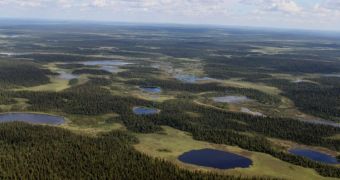Data collected back in 2007, near Murmansk, in northwestern Russia, indicate that the emergence of oxygen in Earth's atmosphere did not occur in a single bound, but rather in small steps characterized by numerous starts and stops.
This long series of false beginnings makes a lot more sense when fitted to available data than any other type of explanation, say investigators who conducted the Fennoscandia Arctic Russia – Drilling Early Earth Project (FAR DEEP).
The endeavor was an integrated part of the International Continental Scientific Drilling Program, which involves hundreds of scientists from around the world. The main goal of FAR DEEP was to gather and analyze rock cores collected from deep underground.
Finding out how and when oxygen appeared in Earth's atmosphere is extremely important for studies dealing with the origins of complex life. It was only after the chemical made its way into air that complex life could develop here, including birds, mammals and humans.
FAR DEEP was focused on a region of the geological layer belonging to the Proterozoic Eon, which spanned from 2.5 billion years ago to 542 million years ago. When it came to an end, the Earth was already populated with lesser lifeforms, and oxygen was present in high concentrations.
“We've always thought that oxygen came into the atmosphere really quickly during an event. We are no longer looking for an event. Now we're looking for when and why oxygen became a stable part of the Earth's atmosphere,” Pennsylvania State University geoscientist Lee Kump explained.
The main implication the new work carries is that the Great Oxidation Event (GOE) that brought oxygen to Earth's atmosphere, took place over millions of years, not briefly. The study is in tune with findings derived from a research carried out in Gabon, which produced a similar proposal.
Details of the 2007 study were published in this week's issue of the top journal Science Express. “The definition of when an oxygen atmosphere occurred depends on which threshold you are looking for,” says Kump, the lead author of the research.
He explains that chemicals such as iron and sulfur would take up most of the oxygen in the air that was produced by single-celled organisms. The chemical would then be used for oxidation, and not make its way back into the atmosphere.
“Insights into Earth's carbon cycle offer tantalizing clues to the history of atmospheric oxygen levels, and Kump and others have revealed unrecognized details of the timing and mechanism of the Great Oxidation Event,” says Enriqueta Barrera.
The expert holds an appointment as a program director with the National Science Foundation (NSF) Division of Earth Sciences. The DES provided the bulk of funding for this research, with the NASA Astrobiology Institute contributing as well.

 14 DAY TRIAL //
14 DAY TRIAL //